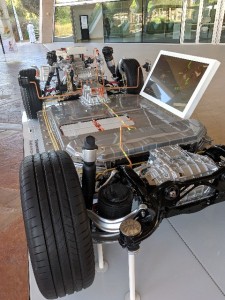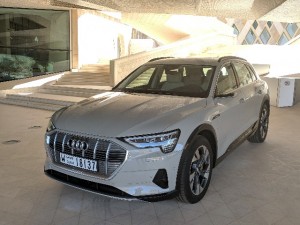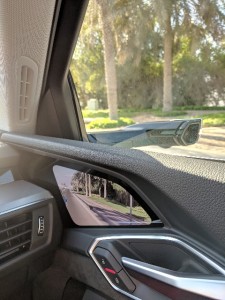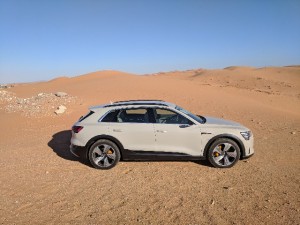2019 Audi e-tron SUV first test drive
The Global press launch for all-electric 2019 Audi e-tron SUV was held in Abu Dhabi, yes the oil producing Arab Emirate. 
Abu Dhabi seemed an unusual choice at first but after a few hours on the ground, it became clear that the oil producing Emirate realizes that the black gooey resource has a limited shelf life and is trying to move away into more sustainable investments and energy sources.
Looking at the gleaming row of Audi e-tron SUV’s sitting against the desert sun, one could be excused for not realizing this was the opening volley in Audi’s assault on the high stakes, electric vehicle market. The e-tron doesn’t scream EV-high-occupancy lane transport. It has essentially the same design language as the other Audi SUV’s.
The 2019 Audi e-tron is built on a modified version of the MLB evo platform that hosts the slightly larger Q7 SUV. The vehicle is powered by a pair of electric motors sitting atop each axle. Yes, the e-tron is equipped with a new all-electric Quattro all-wheel-drive system. The system is devoid of any mechanical connections between the front and rear axle, power is apportioned by onboard electronics and power from one side to the other is controlled by wheel braking. The front motor produces slightly less than the rear, mimicking the rear wheel bias of earlier Quattro systems. 
The combined output of both electric motors is equivalent to 402HP and 490 lb-ft of torque. These are impressive numbers and they need to be in order to propel the 2,560kg (5,643.8lb) vehicle to 100 kms/hr in 5.7 seconds. The e-tron has a top speed of 200 kms/hr or 124 miles per hour.
The almost literal elephant in the room is the 95 kw/hr battery that sits as a floor pan on the e-tron. The massive battery is encased in a structurally engineered case to prevent damage form side impacts. The 700 kg battery represents 30% of the manufacturing cost of the e-tron and almost of the same percentage of its curb weight. To put the size of this battery in perspective, the flagship Tesla’s are fitted with a roughly similar 100 kw/hr battery. The battery provides the e-tron with a projected range of 400 kms in ideal conditions. Our observed range in mid-20’s C temps, was within a few kms of the 400 projected range.
The Audi e-tron SUV comes standard with an onboard 11kw charger with an optional extra 11kw charger available. The single charger will convert current from a 240v service to a full charge in 8.5 hrs. The additional charger halves that time. Fast charging is also an option with direct DC input from 150kw fast chargers being installed as part of the EV charging infrastructure Globally. The direct charging will bring the batteries up to 80% in 30 minutes, which will be the benchmark for fast charging capabilities, surpassing Tesla and the upcoming Mercedes options. I often wondered why companies use the magic 80% figure as a charging gauge. Apparently the rapid influx of energy can cause damage to the battery, so to prolong battery life, the system shuts down charging at 80% to prevent over-heating and resultant damage.
 Inside the vehicle, once again there is very little hint of the electrified powertrain, just the typical Audi refinement and ergonomic efficiency. The Audi virtual cockpit can be adjusted to show the electrical flow and range associated with the vehicle’s power management. Other than that the screen options are similar to those found on the Q7 or Q8.
Inside the vehicle, once again there is very little hint of the electrified powertrain, just the typical Audi refinement and ergonomic efficiency. The Audi virtual cockpit can be adjusted to show the electrical flow and range associated with the vehicle’s power management. Other than that the screen options are similar to those found on the Q7 or Q8.
Seating is a conventional two row arrangement, no three row option is available. The seats are, as we have come to expect in this class of vehicle, comfortable and supportive. Visibility from the drivers seat is excellent and offers a commanding view of the road and desert landscape around us. 
One unusual feature on the new e-tron are external door mounted cameras designed to replace bulky side view mirrors. The cameras are connected to door panel mounted LCD screens that are roughly the same size as the mirror surfaces they replace. The advantages of the new technology include less wind noise and improved aerodynamic performance. The downside is there is a bit of a learning curve in terms of figuring out the visual scale of the objects shown in the monitors, in other words, are the objects shown closer than they appear? Due to government regulation, the virtual mirrors will not be coming to North America.
On the road the e-tron has commendable acceleration, as mentioned 0-100kms/hr in 5.7 is quick. The power-train delivers power in a linear fashion and quiet is comfortingly not silent. There is still a mechanical noise fed back from the low rolling resistance tires as they meet the road.
The braking system relies on regenerative resistance to perform most of the mechanical stopping power but there is no hydraulic system onboard to perform braking function. A brake by wire system has been developed that uses a synthetic pedal feel, to replicate the feel of a traditional hydraulic system. The setup is seamless and provides realistic brake feel.
The new Audi e-tron also comes with an unknown towing capacity, although Audi has demonstrated an e-tron hauling a 1,450 kg (3,200 lbs) race car, sitting on a covered trailer. The whole package looked to be about 5,000lbs.
As the massive battery sits flat on the floor of the e-tron platform, the rear cargo area has a flat floor and provides 660L of usable storage. The relatively upright angle of the rear glass provides more utility for this space than other SUV’s that have a heavily slanted rear tailgate.
The e-tron has the usual slate of safety equipment with perimeter camera sensors and cameras monitoring traffic and obstacles, lane assist, Audi pre-sense accident avoidance but something new was added in the e-tron. The vehicle monitors its onboard GPS and camera inputs to commence partial braking ahead of intersections and sharp bends in the road. 
Overall the 2019 Audi e-tron reflects years of development and research into the technological and markets factors that impact Electric Vehicles coming to market. The e-tron is a real world vehicle built for everyday use and designed to fill the needs of average drivers. It does lack the Electric Crusader visibility of the Tesla X and its various gimmick modes. The trade off can be measured by a price tag for the e-tron that starts at around $90,000 Cdn vs the $136,000 for the Model X with 100 kw/hr battery, but which quickly runs close to $200,000 if you want the performance model. 
The 2019 Audi e-tron will start arriving in dealerships in the second quarter of 2019. 
Copyright © Auto Reviews Online 2016 | Privacy & Terms of Use | info@autoreviewsonline.com | Website by Brolly Media
